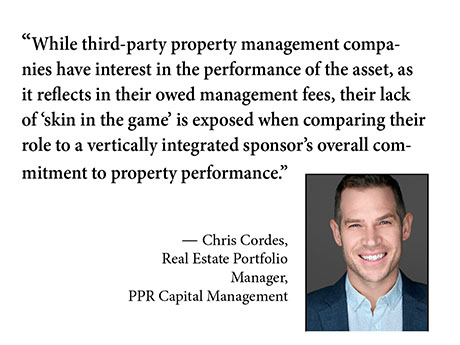By Chris Cordes, real estate portfolio manager, PPR Capital Management
When seeking a sponsor for multifamily partnerships, it’s critical to consider one that offers worthy qualities for the joint venture, since this individual or company will be in charge of managing the property on behalf of the partnership. Worthiness is measured by the ability to be resourceful and versatile. When determining the worthiness of a sponsor, there’s an old expression that can be helpful to keep in mind: “You’re only worth as much as the pocketknife that you carry.”
The pocketknife is a simple tool that offers incredible assistance when utilized for daily tasks. While this device is particularly useful when completing common tasks, it’s important to select the right type of pocketknife. Often, a knife with a single blade will not always get the job done, and you’ll need something else to finish a task. The iconic Swiss Army Knife solves that issue. The historic and versatile multi-use device is known for including varying types of pivoting tools that offer a secured level of preparedness in a compact way.

During the sponsor screening process, the main equity partner should examine the qualities a sponsor presents and determine whether the sponsor offers more than the simplicity of the pocketknife or if they provide the versatility of a Swiss Army Knife. A versatile sponsor can contribute equity, provide robust reporting and, most importantly, is vertically integrated via property management.
Sponsor property management vertical integration is comparable to the pair of scissors found within the Swiss Army Knife. They both provide an elevated level of versatility and preparedness. Furthermore, sponsor property management vertical integration is incredibly beneficial to the partnership and overall asset performance, and preferable when selecting amongst third-party property managers.
Third-Party vs. Vertical Integration
Third-party property management companies have an important place in the multifamily space and play a valuable role when sponsors are looking to build scale. They generally have established reporting formats, are knowledgeable when preparing operational budgets and offer submarket insight.
While a third-party property management company has interest in the performance of the asset, as it reflects in their owed management fee, their lack of “skin in the game” is exposed when comparing their role to a vertically integrated sponsor’s overall commitment to property performance.
It’s customary for a vertically integrated sponsor to contribute equity to an acquisition. Therefore, asset performance beyond achieving a consistent and stable management fee reaches toward establishing net operating income (NOI) at the highest level achievable for a successful deal exit. NOI performance and exit pricing will always be primary focal points for vertically integrated sponsors, as these issues will reflect the amount of proceeds returned to the sponsor based on pre-negotiated terms.
The market standard property management fee structure is generally 3 percent of effective gross income; however, it is not unusual for third-party property management companies to request 4 percent, which can affect the NOI and in turn, exit pricing. Because vertically integrated sponsors have additional interest in the asset, they typically keep management fees at market rates and limit the controllable expenses.
Vertically integrated sponsors gravitate to their cultivated markets and maintain operations therein, where they have secured an established network of vendors, personnel and suppliers, allowing budgets to operate smoothly and efficiently. Third-party property management companies, on the other hand, often operate at a larger scale, some even at a national level, allowing for potential oversight issues that can restrict their familiarity of a submarket in comparison to a “boots on the ground” vertically integrated sponsor.
In situations where a third-property management company is used, the sponsor has an added role of mediator in terms of communications amongst all parties. Protocol determines the chain of command when related to main equity requests for reporting, financial records and annual tax documents. Eliminating an extra party and partnering with a vertically integrated sponsor promotes communication, alignment and the avoidance of placing each party in a silo.
As the analysis above outlines, there are clear benefits of partnering with a vertically integrated sponsor. When pursuing a partnership with a sponsor, it’s important to remember the pocketknife adage and take into consideration the sponsor’s level of versatility. Their ability to take on the role of the Swiss Army Knife will make all the difference.


